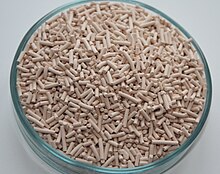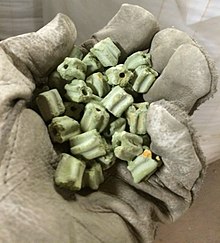Catalysis


Catalysis (/kəˈtæləsɪs/) is the increase in rate of a chemical reaction due to an added substance known as a catalyst[1][2] (/ˈkætəlɪst/). Catalysts are not consumed by the reaction and remain unchanged after it.[3] If the reaction is rapid and the catalyst recycles quickly, very small amounts of catalyst often suffice;[4] mixing, surface area, and temperature are important factors in reaction rate. Catalysts generally react with one or more reactants to form intermediates that subsequently give the final reaction product, in the process of regenerating the catalyst.
The rate increase occurs because the catalyst allows the reaction to occur by an alternative mechanism which may be much faster than the non-catalyzed mechanism. However the non-catalyzed mechanism does remain possible, so that the total rate (catalyzed plus non-catalyzed) can only increase in the presence of the catalyst and never decrease.[5]
Catalysis may be classified as either homogeneous, whose components are dispersed in the same phase (usually gaseous or liquid) as the reactant, or heterogeneous, whose components are not in the same phase. Enzymes and other biocatalysts are often considered as a third category.
Catalysis is ubiquitous in chemical industry of all kinds.[6] Estimates are that 90% of all commercially produced chemical products involve catalysts at some stage in the process of their manufacture.
The term "catalyst" is derived from Greek καταλύειν, kataluein, meaning "loosen" or "untie". The concept of catalysis was invented by chemist Elizabeth Fulhame, based on her novel work in oxidation-reduction experiments.[7][8]
General principles
Example
An illustrative example is the effect of catalysts to speed the decomposition of hydrogen peroxide into water and oxygen:
- 2 H2O2 → 2 H2O + O2
This reaction proceeds because the reaction products are more stable than the starting compound, but this decomposition is so slow that hydrogen peroxide solutions are commercially available. In the presence of a catalyst such as
Units
The SI derived unit for measuring the catalytic activity of a catalyst is the katal, which is quantified in moles per second. The productivity of a catalyst can be described by the turnover number (or TON) and the catalytic activity by the turn over frequency (TOF), which is the TON per time unit. The biochemical equivalent is the enzyme unit. For more information on the efficiency of enzymatic catalysis, see the article on enzymes.
Catalytic reaction mechanisms
In general, chemical reactions occur faster in the presence of a catalyst because the catalyst provides an alternative reaction mechanism (reaction pathway) having a lower activation energy than the non-catalyzed mechanism. In catalyzed mechanisms, the catalyst is regenerated.[10][11][12][13]
As a simple example occurring in the gas phase, the reaction 2 SO2 + O2 → 2 SO3 can be catalyzed by adding nitric oxide. The reaction occurs in two steps:
- 2 NO + O2 → 2 NO2 (rate-determining)
- NO2 + SO2 → NO + SO3 (fast)
The NO catalyst is regenerated. The overall rate is the rate of the slow step[13]
- v = 2k1[NO]2[O2].
An example of
Reaction energetics

Catalysts enable pathways that differ from the uncatalyzed reactions. These pathways have lower activation energy. Consequently, more molecular collisions have the energy needed to reach the transition state. Hence, catalysts can enable reactions that would otherwise be blocked or slowed by a kinetic barrier. The catalyst may increase the reaction rate or selectivity, or enable the reaction at lower temperatures. This effect can be illustrated with an energy profile diagram.
In the catalyzed
The catalyst stabilizes the transition state more than it stabilizes the starting material. It decreases the kinetic barrier by decreasing the difference in energy between starting material and the transition state. It does not change the energy difference between starting materials and products (thermodynamic barrier), or the available energy (this is provided by the environment as heat or light).
Related concepts
Some so-called catalysts are really
In cooperative catalysis, chemical species that improve catalytic activity are called cocatalysts or promoters.
In
In autocatalysis, the catalyst is a product of the overall reaction, in contrast to all other types of catalysis considered in this article. The simplest example of autocatalysis is a reaction of type A + B → 2 B, in one or in several steps. The overall reaction is just A → B, so that B is a product. But since B is also a reactant, it may be present in the rate equation and affect the reaction rate. As the reaction proceeds, the concentration of B increases and can accelerate the reaction as a catalyst. In effect, the reaction accelerates itself or is autocatalyzed. An example is the hydrolysis of an ester such as aspirin to a carboxylic acid and an alcohol. In the absence of added acid catalysts, the carboxylic acid product catalyzes the hydrolysis.
A true catalyst can work in tandem with a sacrificial catalyst. The true catalyst is consumed in the elementary reaction and turned into a deactivated form. The sacrificial catalyst regenerates the true catalyst for another cycle. The sacrificial catalyst is consumed in the reaction, and as such, it is not really a catalyst, but a reagent. For example,
Classification
Catalysis may be classified as either
Heterogeneous catalysis


Heterogeneous catalysts act in a different
Diverse mechanisms for
A heterogeneous catalyst has active sites, which are the atoms or crystal faces where the substrate actually binds. Active sites are atoms but are often described as a facet (edge, surface, step, etc.) of a solid. Most of the volume but also most of the surface of a heterogeneous catalyst may be catalytically inactive. Finding out the nature of the active site is technically challenging.
For example, the catalyst for the Haber process for the synthesis of ammonia from nitrogen and hydrogen is often described as iron. But detailed studies and many optimizations have led to catalysts that are mixtures of iron-potassium-calcium-aluminum-oxide.[20] The reacting gases adsorb onto active sites on the iron particles. Once physically adsorbed, the reagents partially or wholly dissociate and form new bonds. In this way the particularly strong triple bond in nitrogen is broken, which would be extremely uncommon in the gas phase due to its high activation energy. Thus, the activation energy of the overall reaction is lowered, and the rate of reaction increases.[21] Another place where a heterogeneous catalyst is applied is in the oxidation of sulfur dioxide on vanadium(V) oxide for the production of sulfuric acid.[18] Many heterogeneous catalysts are in fact nanomaterials.
Heterogeneous catalysts are typically "
Electrocatalysts
In the context of
Homogeneous catalysis
Homogeneous catalysts function in the same phase as the reactants. Typically homogeneous catalysts are dissolved in a solvent with the substrates. One example of homogeneous catalysis involves the influence of
Organocatalysis
Whereas transition metals sometimes attract most of the attention in the study of catalysis, small organic molecules without metals can also exhibit catalytic properties, as is apparent from the fact that many
Photocatalysts
Photocatalysis is the phenomenon where the catalyst can receive light to generate an excited state that effect redox reactions.[26] Singlet oxygen is usually produced by photocatalysis. Photocatalysts are components of dye-sensitized solar cells.
Enzymes and biocatalysts
In biology, enzymes are protein-based catalysts in metabolism and catabolism. Most biocatalysts are enzymes, but other non-protein-based classes of biomolecules also exhibit catalytic properties including ribozymes, and synthetic deoxyribozymes.[27]
Biocatalysts can be thought of as an intermediate between homogeneous and heterogeneous catalysts, although strictly speaking soluble enzymes are homogeneous catalysts and membrane-bound enzymes are heterogeneous. Several factors affect the activity of enzymes (and other catalysts) including temperature, pH, the concentration of enzymes, substrate, and products. A particularly important reagent in enzymatic reactions is water, which is the product of many bond-forming reactions and a reactant in many bond-breaking processes.
In biocatalysis, enzymes are employed to prepare many commodity chemicals including high-fructose corn syrup and acrylamide.
Some
Significance
Estimates are that 90% of all commercially produced chemical products involve catalysts at some stage in the process of their manufacture.[30] In 2005, catalytic processes generated about $900 billion in products worldwide.[31] Catalysis is so pervasive that subareas are not readily classified. Some areas of particular concentration are surveyed below.
Energy processing
- 2 CO + 2 NO → 2 CO2 + N2
With regard to synthetic fuels, an old but still important process is the
Fuel cells rely on catalysts for both the anodic and cathodic reactions.
Catalytic heaters generate flameless heat from a supply of combustible fuel.
Bulk chemicals

Some of the largest-scale chemicals are produced via catalytic oxidation, often using oxygen. Examples include nitric acid (from ammonia), sulfuric acid (from sulfur dioxide to sulfur trioxide by the contact process), terephthalic acid from p-xylene, acrylic acid from propylene or propane and acrylonitrile from propane and ammonia.[19]
The production of ammonia is one of the largest-scale and most energy-intensive processes. In the Haber process nitrogen is combined with hydrogen over an iron oxide catalyst.[32] Methanol is prepared from carbon monoxide or carbon dioxide but using copper-zinc catalysts.
Bulk polymers derived from
Most
Fine chemicals
Many

Food processing
One of the most obvious applications of catalysis is the hydrogenation (reaction with hydrogen gas) of fats using nickel catalyst to produce margarine.[34] Many other foodstuffs are prepared via biocatalysis (see below).
Environment
Catalysis affects the environment by increasing the efficiency of industrial processes, but catalysis also plays a direct role in the environment. A notable example is the catalytic role of
- Cl· + O3 → ClO· + O2
- ClO· + O· → Cl· + O2
History
The term "catalyst", broadly defined as anything that increases the rate of a process, is derived from
Inhibitors, poisons, and promoters
An added substance that lowers the rate is called a reaction inhibitor if reversible and catalyst poisons if irreversible.[1] Promoters are substances that increase the catalytic activity, even though they are not catalysts by themselves.[43]
Inhibitors are sometimes referred to as "negative catalysts" since they decrease the reaction rate. side products.
The inhibitor may modify selectivity in addition to rate. For instance, in the hydrogenation of alkynes to alkenes, a palladium (Pd) catalyst partly "poisoned" with lead(II) acetate (Pb(CH3CO2)2) can be used(Lindlar catalyst).[45] Without the deactivation of the catalyst, the alkene produced would be further hydrogenated to alkane.[46][47]
The inhibitor can produce this effect by, e.g., selectively poisoning only certain types of active sites. Another mechanism is the modification of surface geometry. For instance, in hydrogenation operations, large planes of metal surface function as sites of hydrogenolysis catalysis while sites catalyzing hydrogenation of unsaturates are smaller. Thus, a poison that covers the surface randomly will tend to lower the number of uncontaminated large planes but leave proportionally smaller sites free, thus changing the hydrogenation vs. hydrogenolysis selectivity. Many other mechanisms are also possible.
Promoters can cover up the surface to prevent the production of a mat of coke, or even actively remove such material (e.g., rhenium on platinum in platforming). They can aid the dispersion of the catalytic material or bind to reagents.
See also
- Chemical reaction
- Abzyme
- Acid catalysis (includes Base catalysis)
- Autocatalysis
- BIG-NSE (Berlin Graduate School of Natural Sciences and Engineering)
- Catalysis Science & Technology (a chemistry journal)
- Catalytic resonance theory
- Electrocatalyst
- Environmental triggers
- Enzyme catalysis
- Industrial catalysts
- Kelvin probe force microscope
- Limiting reagent
- Murburn concept
- Pharmaceutic adjuvant
- Phase-boundary catalysis
- Phase transfer catalyst
- Photocatalysis
- Ribozyme (RNA biocatalyst)
- SUMO enzymes
- Temperature-programmed reduction
- Thermal desorption spectroscopy
References
- ^ ISBN 978-0-9678550-9-7.
- ISBN 0-471-24197-0.
- ISBN 0-13-737123-3.
A catalyst is defined as a chemical substance which increases the rate of a chemical reaction without itself being consumed in the reaction.
- ^ Lerner, Louise (2011). "7 things you may not know about catalysis". Argonne National Laboratory.
- ISBN 0-8053-5682-7.
Inhibitors do not work by introducing a higher reaction path; this would not reduce the rate, since the reaction would continue to occur by the alternative mechanism
- S2CID 255047115.
- ^ ISBN 9788437033280. Archived from the original(PDF) on January 23, 2015. Retrieved March 14, 2021.
- ^ ISBN 978-0-8412-3522-9.
- ^ "Genie in a Bottle". University of Minnesota. March 2, 2005. Archived from the original on April 5, 2008.
- ^ ISBN 0-618-12341-5.
- ISBN 0-8053-5682-7.
- ISBN 0-7167-8759-8.
The catalyst lowers the activation energy of the reaction by providing an alternative path that avoids the slow, rate-determining step of the uncatalyzed reaction
- ^ ISBN 0-13-737123-3.
The catalyst concentration [C] appears in the rate expression, but not in the equilibrium ratio.
- ^ Jacoby, Mitch (February 16, 2009). "Making Water Step by Step". Chemical & Engineering News. p. 10.
- PMID 19309169.
- ^ Robertson, A.J.B. (1970) Catalysis of Gas Reactions by Metals. Logos Press, London.
- S2CID 225777024.
- ^ ISBN 0130-39913-2.
- ^
- ISBN 3527306730.
- ^ "Chemistry of Vanadium". Chemistry LibreTexts. October 3, 2013. Retrieved July 8, 2022.
- ISSN 1687-8434.
- ISBN 978-3-527-29390-2
- ^ "The Nobel Prize in Chemistry 2021". NobelPrize.org.
- S2CID 246287799.
- ISBN 1-57259-153-6.
- ^ Catalytic Antibodies Simply Explained. Documentroot.com (2010-03-06). Retrieved on 2015-11-11.
- (PDF) from the original on March 28, 2019.
- ^ "Recognizing the Best in Innovation: Breakthrough Catalyst". R&D Magazine, September 2005, p. 20.
- ^ 1.4.3 Iindustrial Process Efficiency Archived 2008-05-17 at the Wayback Machine. climatetechnology.gov
- ISBN 9780262693134.
- S2CID 106394152.
- ^ Clark, Jim (October 2013). "Types of catalysis". Chemguide.
- ^ Bård Lindström and Lars J. Petterson (2003) "A brief history of catalysis" Cattech, 7 (4) : 130–38.
- ^ Berzelius, J.J. (1835) Årsberättelsen om framsteg i fysik och kemi [Annual report on progress in physics and chemistry]. Stockholm, Sweden: Royal Swedish Academy of Sciences. After reviewing Eilhard Mitscherlich's research on the formation of ether, Berzelius coins the word katalys (catalysis) on p. 245:
Original: Jag skall derföre, för att begagna en i kemien välkänd härledning, kalla den kroppars katalytiska kraft, sönderdelning genom denna kraft katalys, likasom vi med ordet analys beteckna åtskiljandet af kroppars beståndsdelar medelst den vanliga kemiska frändskapen.
Translation: I shall, therefore, to employ a well-known derivation in chemistry, call [the catalytic] bodies [i.e., substances] the catalytic force and the decomposition of [other] bodies by this force catalysis, just as we signify by the word analysis the separation of the constituents of bodies by the usual chemical affinities.
- .
- ^ Döbereiner (1822). "Glühendes Verbrennen des Alkohols durch verschiedene erhitzte Metalle und Metalloxyde" [Incandescent burning of alcohol by various heated metals and metal oxides]. Journal für Chemie und Physik. 34: 91–92.
- ^ Döbereiner (1823). "Neu entdeckte merkwürdige Eigenschaften des Platinsuboxyds, des oxydirten Schwefel-Platins und des metallischen Platinstaubes" [Newly discovered remarkable properties of platinum suboxide, oxidized platinum sulfide and metallic platinum dust]. Journal für Chemie und Physik. 38: 321–26.
- S2CID 97988261.
- S2CID 91507819.
- .
- ISBN 9789352830688.
- ^ ISBN 0-8053-5680-0.
- ; Collected Volumes, vol. 5, p. 880.
- ISBN 0-07-032305-4
- ISBN 0-471-05991-9
External links
- Science Aid: Catalysts Page for high school level science
- W.A. Herrmann Technische Universität presentation Archived October 28, 2005, at the Wayback Machine
- Alumite Catalyst, Kameyama-Sakurai Laboratory, Japan
- Inorganic Chemistry and Catalysis Group, Utrecht University, The Netherlands
- Centre for Surface Chemistry and Catalysis
- Carbons & Catalysts Group, University of Concepcion, Chile
- Center for Enabling New Technologies Through Catalysis, An NSF Center for Chemical Innovation, USA
- "Bubbles turn on chemical catalysts" Archived July 22, 2012, at the Wayback Machine, Science News magazine online, April 6, 2009.

